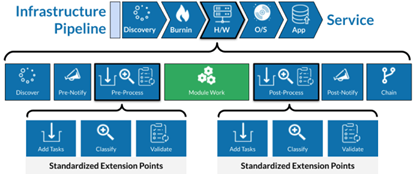BrainBlog post for RackN by Jason Bloomberg
Compared to cloud computing, bare metal servers sound like a lot of trouble.
 According to conventional wisdom, cloud infrastructure is the wondrous Camelot of lore, while bare metal servers are the evil dragon that noble knights must slay to preserve the kingdom.
According to conventional wisdom, cloud infrastructure is the wondrous Camelot of lore, while bare metal servers are the evil dragon that noble knights must slay to preserve the kingdom.
Just one problem: this comparison is a myth. In reality, self-managed infrastructure based on bare metal compares favorably to cloud alternatives – once you dispel the myths of bare metal.
Five Common Myths of Bare Metal Automation
Let’s tackle the common myths of bare metal servers one at a time.
Myth #1: Configuring bare metal servers is a manual process
As I explained in the first article in this series, repatriating workloads from the cloud to bare metal servers either on-premises or in a colo facility doesn’t mean giving up on the ‘cattle, not pets’ principle of automated cloud provisioning.
Instead, modern data center operators bring cloud best practices in-house to provision and manage bare metal servers with infrastructure platforms.
As a result, with the right automation software, self-managing bare metal infrastructure is straightforward and cost-effective.
Myth #2: Bare metal doesn’t scale
The cloud gives the impression that there are an infinite number of instances available on demand, so even the largest deployments have horizontal scale to spare.
In contrast, an organization must purchase enough bare metal servers to meet their needs – setting a limit on how far such deployments can respond to unplanned requirements for additional scale.
To dispel this myth, consider the respective costs of each approach. The more you provision in the cloud, the more it costs – without providing much in the way of economies of scale (the cloud provider gets such economies, not its customers).
With bare metal provisioning, purchasing additional servers provides increasing economies of scale, as data center infrastructure and management costs spread out across the deployed infrastructure.
Scaling horizontally costs more either way – but investing in bare metal ends up costing less as the requirement for scale ramps up.
Myth #3: Bare metal is more expensive
As with horizontal scalability, there is always a point where the economies of scale for bare metal provide lower costs overall (that is, lower total cost of ownership or TCO) than public cloud alternatives.
Cloud computing is ideal for smaller or highly variable deployments that can take advantage of its ease-of-use and pay-as-you-go pricing, but at some critical tipping point, larger self-managed bare metal deployments are always less expensive.
Furthermore, workloads that have predictable infrastructure requirements don’t require unlimited scalability. The additional costs of the cloud’s unlimited scale are unnecessary for predictable enterprise workloads.
Myth #4: Bare metal lacks core capabilities like redundancy and disaster recovery
The reality is that bare metal deployments give organizations the freedom to provision core capabilities any way they like – as well as any specialized capabilities they might require.
Public clouds provide the flexibility of selecting core capabilities as well – but off a marketplace or other list of available options. If the organization wants something special, its operators must deploy it themselves, just as they would with bare metal.
Myth #5: Bare metal is hard to manage
Without the right tooling, bare metal deployments are indeed difficult to manage. Managing bare metal infrastructure is complicated, as components are always changing, different organizational silos must work together, and cybersecurity concerns require constant vigilance.
Furthermore, most cloud management technologies aren’t up to the task. Bare metal presents unique challenges that neither preconfigured servers nor cloud deployments present.
These challenges, furthermore, connect to some of the most important reasons to implement platforms for self-managed infrastructure in the first place: the ability to configure firmware, hypervisors, and operating systems on any hardware.
It is critical for organizations to adopt standard management processes with the right tools to meet their specific business needs. There are integrated offerings that can support such processes.
Dispelling the myths
As my colleague Eric Newcomer explained in the previous article in this series, obtaining the competitive advantages of cloud computing with self-managed infrastructure depends upon sophisticated infrastructure automation, application automation that supports DevOps practices, and an API-based operations model that supports whatever application architecture the organization requires, including cloud native computing.
To dispel the myths of bare metal automation, therefore, organizations require self-managing infrastructure technology like RackN Digital Rebar that can deliver these advantages.
Solving Bare Metal Automation Challenges with RackN
RackN has designed Digital Rebar to build infrastructure-as-code (IaC) workflows for bare metal infrastructures. These workflows include:
- The automation of event-driven orchestration – Digital Rebar includes pre-built pipelines for choreographing event-driven environments, from network devices to Kubernetes clusters.
- Composable automations – Digital Rebar provides a full-lifecycle IaC platform comprising development, test, and production rollout processes that support composable automations at scale.
- Declarative APIs – Operators can create a bare metal cloud via APIs. They are thus able to customize the deployments automatically to meet varied business needs.
- Infrastructure pipelines – Digital Rebar connects existing processes and automations via IaC pipelines that enable operators to create system-level processes at any layer in the system hierarchy.
By leveraging composable automations and declarative APIs, operators can build infrastructure pipelines that compose component pipelines, thus creating automations that can handle any level of complexity, as the figure below illustrates.

Composable Infrastructure Pipelines (source: RackN)
The Intellyx Take
The greatest self-managed infrastructure challenge is balancing flexibility and simplicity.
Such infrastructure is inherently complicated. Any simplification of the infrastructure is likely to limit its flexibility, and increased flexibility necessarily sacrifices simplicity.
RackN enables its customers to break out of this conundrum. Via infrastructure pipelines that leverage composable automations, declarative APIs, and event-driven orchestration, RackN Digital Rebar enables organizations to slay the bare metal dragons of myth by providing the cost and flexibility benefits of bare metal with the simplicity and automation of the cloud.
Copyright © Intellyx BV. Intellyx retains final editorial control of this article. RackN is an Intellyx customer. No AI was used to write this article. Image credit: RackN.



